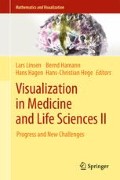Abstract
We present a novel method that uses shape skeletons, and associated quantities, for feature-preserving smoothing of digital (black-and-white) binary shapes. We preserve, or smooth out, features based on a saliency measure that relates feature size to local object size, both computed using the shape’s skeleton. Low-saliency convex features (cusps) are smoothed out, and low-saliency concave features (dents) are filled in, respectively, by inflating simplified versions of the shape’s foreground and background skeletons. The method is simple to implement, works in real time, and robustly removes large-scale contour and binary speckle noise while preserving salient features. We demonstrate the method with several examples on datasets from the shape analysis application domain.
Access this chapter
Tax calculation will be finalised at checkout
Purchases are for personal use only
Preview
Unable to display preview. Download preview PDF.
References
T. Alter and R. Basri. Extracting salient curves from images: An analysis of the saliency network. Intl. J. of Computer Vision, 27(1):51-69, 1995.
N. Amenta, S. Choi, and K. Kolluri. The power crust. In Proc. Solid Modeling, 249-260. IEEE, 2001.
J. August, K. Siddiqi, and S. W. Zucker. Ligature instabilities in the perceptual organization of shape. CVIU, 76(3):231-249, 1999.
X. Bai, J. Latecki, and W. Y. Liu. Skeleton pruning by contour partitioning with discrete curve evolution. IEEE TPAMI, 29(3):449-462, 2007.
U. Clarenz, U. Diewald, and M. Rumpf. Processing textured surfaces via anisotropic geometric diffusion. IEEE Trans. Image Proc., 13(2):248261, 2004.
U. Clarenz, M. Rumpf, and A. Telea. Robust feature detection and local classification of surfaces based on moment analysis. IEEE TVCG, 10(5):516-524, 2004.
Mathieu Desbrun, Mark Meyer, Peter Schröder, and Alan H. Barr. Implicit fairing of irregular meshes using diffusion and curvature flow. In Proc. ACM SIGGRAPH, 317-324, 1999.
G. Dudek and J. K. Tsotsos. Shape representation and recognition from multiscale curvatures. CVIU, 68(4):170189, 1997.
C. Fernmuller and W. Kropatsch. Multiresolution shape description by corners. In Proc. CVPR, page 271276. IEEE, 1992.
S. Fleishman, I. Drori, and D. Cohen-Or. Bilateral mesh denoising. ACM TOG, 22(3):950953, 2003.
M. Hisada, A. Belyaev, and L. Kunii. A skeleton-based approach for detection of perceptually salient features on polygonal surfaces. Computer Graphics Forum, 21(4):689700, 2002.
A. Jalba, M. Wilkinson, and J. Roerdink. Shape representation and recognition through morphological scale spaces. IEEE Trans. Image Proc., 15(2):331341, 2006.
R. Kimmel, D. Shaked, and N. Kiryati. Skeletonization via distance maps and level sets. CVIU, 62 (3):382391, 1995.
J. J. Koenderink. The structure of images. Biological Cybernetics, 50:363370, 1984.
H. Moreton and C. Séquin. Functional optimization for fair surface design. In Proc. ACM SIGGRAPH, 167-176, 1992.
R. L. Ogniewicz and O. Kübler. Hierarchic Voronoi skeletons. Pattern Recognition, 28(3):343-359, 1995.
S. Osher and J. Sethian. Fronts propagating with curvature-dependent speed. J. of Computational Physics, 79:1249, 1988.
J. Peng, V. Strela, and D. Zorin. A simple algorithm for surface denoising. In Proc. IEEE Visualization, page 107112, 2001.
S. M. Pizer, W. R. Oliver, and S. H. Bloomberg. Hierarchical shape description via the multiresolution symmetric axis transform. IEEE TPAMI, 9(4):505511, 1987.
K. Rehm, K. Schaper, J. Anderson, R. Woods, S. Stoltzner, and D. Rottenberg. Putting our heads together: a consensus approach to brain/non-brain segmentation in T1-weighted MR volumes. Neuroimage, 22(3):12621270, 2004.
D. Reniers and A. Telea. Tolerance-based distance transforms. In Advances in Computer Graphics and Computer Vision (eds. J. Braz, A. Ranchordas, H. Araujo, J. Jorge), page 187200.Springer LNCS, 2007.
Dennie Reniers, Jarke Van Wijk, and Alexandru Telea. Computing multiscale curve and surface skeletons of genus 0 shapes using a global importance measure. IEEE TVCG, 14(2):355-368, 2008.
T. B. Sebastian, P. N. Klein, and B. Kimia. Recognition of shapes by editing their shock graphs. IEEE TPAMI, 26(5):550571, 2004.
J. A. Sethian. Level set methods and fast marching methods. Cambridge University Press, 2nd edition, 1999.
M. Shah. MRI brain image segmentation, 2009. www.81bones.net/mri/mri_segmentation.pdf.
K. Siddiqi, A. Shokoufandeh, S. Dickinson, and S. W. Zucker. Shock graphs and shape matching. Intl. J. of Computer Vision, 35(1):1332, 2004.
G. Taubin. Estimating the tensor of curvature of a surface from a polyhedral approximation. In Proc. IEEE ICCV, 992-997, 1995.
H. Tek and B. Kimia. Boundary smoothing via symmetry transforms. J. of Math. Imaging and Vision, 14:211223, 2001.
A. Telea. AFMMStar software, 2009. www.cs.rug.nl/~alext/SOFTWARE/AFMM/afmmstarvdt.zip.
A. Telea and J. J. Van Wijk. An augmented fast marching method for computing skeletons and centerlines. In Proc. Symp. on Data Visualisation (VisSym), 251-259, 2002.
B. ter Haar Romeny. Geometric-Driven Diffusion in Computer Vision. Kluwer, 1994.
J. Weickert. A review of nonlinear diffusion filtering. In Proc. Intl. Conf. on Scale Space, page 328. Utrecht, the Netherlands, 1997.
Author information
Authors and Affiliations
Corresponding author
Editor information
Editors and Affiliations
Rights and permissions
Copyright information
© 2012 Springer-Verlag Berlin Heidelberg
About this paper
Cite this paper
Telea, A. (2012). Feature Preserving Smoothing of Shapes Using Saliency Skeletons. In: Linsen, L., Hagen, H., Hamann, B., Hege, HC. (eds) Visualization in Medicine and Life Sciences II. Mathematics and Visualization. Springer, Berlin, Heidelberg. https://doi.org/10.1007/978-3-642-21608-4_9
Download citation
DOI: https://doi.org/10.1007/978-3-642-21608-4_9
Publisher Name: Springer, Berlin, Heidelberg
Print ISBN: 978-3-642-21607-7
Online ISBN: 978-3-642-21608-4
eBook Packages: Mathematics and StatisticsMathematics and Statistics (R0)

